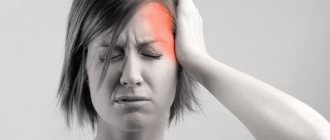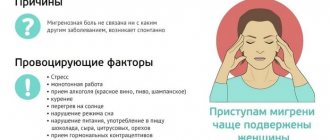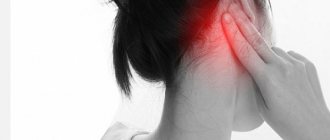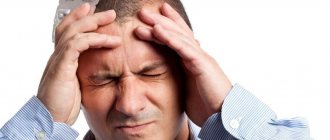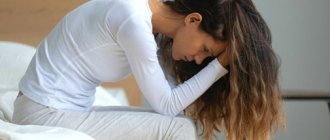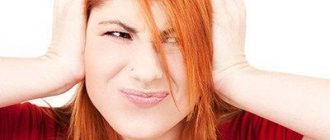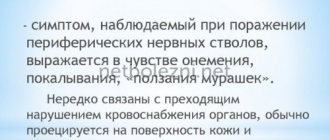A headache in the back of the head is a very unpleasant phenomenon, causing a lot of inconvenience and often limiting performance. The causes of pain in the occipital part of the head can be very different, from diseases of the cervical spine to neuralgic pathologies.
If you don’t know why the back of your head hurts, then this article is for you. It collects the main causes and describes methods of treating headaches in the back of the head. In any case, you must remember: if you have a headache in the back of your head, you should not self-medicate, you need to seek medical help. Of course, we are not talking about isolated cases of pain in the occipital region. As a rule, they are caused by prolonged exposure to an uncomfortable position, stress, extreme hunger, and also due to excessive consumption of foods with caffeine or chemical additives.
Possible reasons
Shooting pain in the head on the right is a symptom of many diseases. They can appear in any healthy person, in the absence of organic disorders of the nerves and blood vessels. In this case, the pain is caused by nervous tension, fatigue after physical exertion, alcohol intoxication or food poisoning. They go away after proper rest. However, headaches can be highly intense or occur with a certain frequency - these types require more detailed diagnosis.
Shooting pain in the head associated with nerve diseases
Unilateral shooting pains in the head (lumbago) are a sign of inflammation or mechanical impact on nerve fibers. On the right side is the trigeminal nerve. It innervates the soft tissues and mucous membranes of the head, upper and lower jaws, as well as the dura mater of the brain. It is represented by the fifth pair of cranial nerves. Its inflammation or mechanical impact causes attacks of neuralgia - nerve pain. It manifests itself with the following symptoms:
- shooting unilateral pain that covers half of the head, intensifies and decreases in certain positions;
- the duration of the attack is from 10 seconds to several minutes, the rest of the time discomfort may be felt along the nerve;
- additional symptoms, including nausea, dizziness, increased heart rate.
Neuritis is an inflammation of the nerve that can occur in a chronic form. Among its causes are hypothermia, decreased immune defense, especially in the off-season, injuries and mechanical pressure on the nerve. The disease requires timely treatment, as it can lead to disruption of the innervation of soft tissues and internal organs, and the membranes of the brain.
Migraine
Another cause of lumbago on the right side of the head is migraine. This is an attack of headache that occurs without an exact cause and is characterized by a certain periodicity. It is accompanied by additional symptoms that occur simultaneously with the headache or precede it. These include:
- dizziness, nausea and vomiting;
- increased sensitivity to light, lacrimation;
- decreased hearing and vision;
- numbness, deterioration of sensitivity of the fingers.
You can relieve migraine symptoms at home with painkillers. However, if this syndrome occurs frequently, specific medications are prescribed that should be taken regularly.
Cluster headaches
Cluster pain is highly intense, but is rarely diagnosed. The exact cause of their appearance remains unknown, but a vascular component is likely. Shooting pain in the head on the right or left side occurs without warning and is accompanied by additional symptoms:
- muscle weakness, drooping of the upper eyelid on one side;
- shortness of breath, which manifests itself even in the absence of physical activity;
- increased sweating, increased heart rate;
- sensitivity to bright light, lacrimation.
Cluster headaches can appear with a clear frequency, occurring at the same time over several weeks or even months. An acute attack lasts no more than 5–10 minutes, but the aching pain and discomfort then continues for several more hours.
Concussion
Impacts to the right side of the head are the main cause of closed head injuries and concussions. Falls and bruises lead to impaired blood circulation in certain areas of the nervous tissue and the appearance of signs of ischemia. The headache associated with a concussion is sharp, shooting, and very intense. Additional signs are also observed:
- blurred vision, appearance of black dots and circles before the eyes;
- nausea, vomiting;
- impaired coordination of movements;
- decreased sensitivity of the limbs;
- fainting.
Headaches can occur long after a traumatic brain injury. The time for complete recovery depends on the size of the damaged area, the age of the patient and the presence of concomitant diseases of the cardiovascular system.
Increased intracranial pressure
Periodic increases in intracranial pressure occur in most of the population, regardless of gender and age. However, it is impossible to accurately measure this indicator at home. It represents the total pressure of all fluids that are in the cranium: the contents of the cerebral ventricles, blood in the vessels, and the brain tissue itself. The diagnosis is made based on indirect signs:
- headache, which can be concentrated on the right side of the head, often has a girdling character;
- soreness in the eye area and behind the eyes, blurred vision;
- nausea, disorders of the digestive system;
- heart rhythm disturbance.
Intracranial hypertension manifests itself in attacks. It may be associated with a lack of oxygen in the room, intense physical activity, stress and tension.
Ear diseases
Otitis is an inflammation of the ear. The disease can be acute or chronic and manifests itself as pain on one side of the head. Depending on the location of the source of inflammation, external, middle and internal otitis are distinguished. Its cause is hypothermia, infectious diseases and acute respiratory viral infections, as well as injuries. It is important to treat otitis media in the early stages, since the disease is dangerous due to the addition of a bacterial component and the development of purulent inflammation. In the later stages, without timely treatment, the infection may spread to the membranes of the brain and develop meningitis.
Diseases of the cervical spine
Pain on the right side of the head can be caused by poor circulation. A common cause is diseases of the cervical spine, in which compression of the arteries supplying the brain occurs. The following disorders can be diagnosed in this area:
- curvature of the spine (scoliosis, kyphosis);
- osteochondrosis is a chronic disease in which damage to intervertebral cartilage occurs, narrowing of the space between the vertebrae and compression of blood vessels;
- spondylosis is a pathological fusion of two adjacent vertebral segments, which occurs as a result of the proliferation of bone tissue;
- intervertebral hernias are the result of protrusion of cartilage due to displacement of the vertebrae, uneven load and incorrect posture.
Shooting pain in the right side of the head is the result of a lack of oxygen in certain areas of the brain. Chronic ischemia is dangerous to health and can lead to stroke. The pain goes away after its underlying cause is eliminated.
Main types of scalp
- Normal, with the sebaceous glands producing only the required amount of sebum to maintain softness and elasticity.
- Dry, with scanty presence of this fat and insufficient supply of nutritional components. The skin dries out and the head itches.
- Flaky dandruff with the appearance of dandruff, scalp burning, discomfort, the patient complains of itching regardless of the type, hormonal imbalance appears.
- Oily, characterized by excess sebum production, tangled and greasy hair.
- The deeper ones produce new cells to replace the dead ones on the surface of the epidermis.
- They exfoliate and are removed from the top layer, gradually renewing the scalp.
- Here are hair follicles, sebaceous and sweat glands, sebum, nerve endings, and cells responsible for immune defense.
- They provide metabolic functions, tactile sensations, and regulate skin temperature.
The structure of the skin includes several layers:
Any failure in these functions can lead to disruption of processes and the appearance of problems when the scalp itches.
Diagnosis of shooting pain in the head on the right side
The Clinical Brain Institute specializes in the diagnosis and treatment of headaches. If it bothers you often or occurs with high intensity, it is recommended to consult a therapist. Based on the results of the examination and medical history, additional consultation with an ENT doctor, neurologist and other specialized specialists may be required. To determine the cause of headache, the following examination methods are prescribed:
- blood tests (clinical and biochemical) - will indicate an increase in the concentration of leukocytes (indicators of inflammation), an imbalance of microelements, an increase in glucose levels and other pathologies;
- MRI, CT of the brain is a modern technique, thanks to which you can obtain a three-dimensional image of the area under study, identify areas of ischemia, neoplasms, and blood supply pathologies;
- ECG (electroencephalography) - analysis of bioelectrical conductivity of nervous tissue;
- ultrasound examination of the vessels of the head and neck;
- special examination techniques by an otolaryngologist to exclude otitis media and other hearing diseases.
Timely and accurate diagnosis is the key to correctly prescribing a treatment regimen. At the Clinical Brain Institute you can undergo a full examination using modern equipment and get the most accurate results.
The back of the head hurts when blood pressure fluctuates. Treatment
High blood pressure is indicated when values above 140/90 millimeters of mercury are recorded. WHO estimates that hypertension affects 10 to 30% of the population in different countries. Only a third of them went to see a doctor, and only a third of those who did take medications prescribed by the doctor. The rest suffer from headaches, take analgesics, but do not associate their condition with hypertension.
Arterial hypertension is divided into primary - essential and secondary, caused by the pathology of other organs and systems:
- renal,
- endocrine,
- pulmogenic,
- hemodynamic,
- central.
In this case, antihypertensive drugs help.
Treatment methods
Doctors will select an individual treatment regimen that will help relieve not only the pain syndrome, but also its cause. Depending on the cause and nature of the headache, the patient’s age and the presence of concomitant diseases, the following techniques may be prescribed:
- drug treatment: for mild headaches, use non-steroidal anti-inflammatory drugs (Ibuprofen), as well as painkillers (Analgin);
- antibiotics - indicated for purulent otitis and other diseases that are accompanied by bacterial infection;
- physiotherapy - a course of procedures designed to improve blood circulation and innervation of certain areas;
- nootropics are substances that improve blood supply to the brain and are used as an addition to the main therapy regimen.
The Clinical Brain Institute provides treatment for headaches of various origins in inpatient or outpatient settings. Therapy is carried out under the supervision of specialists, with constant assessment of its effectiveness and the dynamics of the patient’s condition. Doctors warn that self-medication can be dangerous and lead to complications, so at the first symptoms it is important to seek medical help.
Medical assistance
The specialist prescribes treatment in accordance with the provoking factors. The basis of treatment for most pathologies is medications.
| Pathology | Type of medicine |
| Osteochondrosis | antispasmodics, analgesics, sedatives |
| warming ointments: applied to the cervical area, help relieve tension | |
| blockade: with unbearable pain that spreads to the face | |
| vitamins: used to improve arteries and blood flow through them: C, B, E | |
| Hypertension | ACE inhibitors, beta blockers, diuretics |
| home medicine: herbal teas to lower blood pressure | |
| Neuralgia | prescription of non-steroidal anti-inflammatory drugs |
| in difficult cases - droppers, injections | |
| taking B vitamins: B1, B6, B12 | |
| VSD | sedatives |
| nootropics to improve blood circulation in the brain | |
| tranquilizers | |
| antidepressants | |
| beta blockers |
What to do if you're dry
Choose milder herbal shampoos enriched with plant oils and extracts. They will help restore lost balance and remove increased sensitivity, redness and irritation.
Use argan and olive oil, which contains unsaturated fatty acids and vitamin E (tocopherol), which transform hair into elastic, elastic and silky. They contain linoleic, oleic, palmitic, stearic, vanillic acid, as well as fungicides, tyrosol, and sterols. This composition moisturizes the scalp and strengthens brittle hair.
Take a not too hot shower, wash with slightly warm water. Higher temperatures help remove fat, causing irritation.
Types of skin itching
The condition when the back of the head or the entire skin itches is a protective reaction to remove the irritating factor. There are different types of itching:
- Dermatological, characteristic of atopic dermatitis, scabies, lice, psoriasis.
- Neurological, arising from lesions of the nervous system.
- Systemic, observed in various pathologies of internal organs.
- Psychogenic, appearing under stress and psycho-emotional tension.
- Multifactorial, in the case of simultaneously different causes of origin.
- Idiopathic, with an unclear etiology.
- Other.
